JMS-S3000 SpiralTOF™-plus 3.0
Mass Spectrometry Imaging System
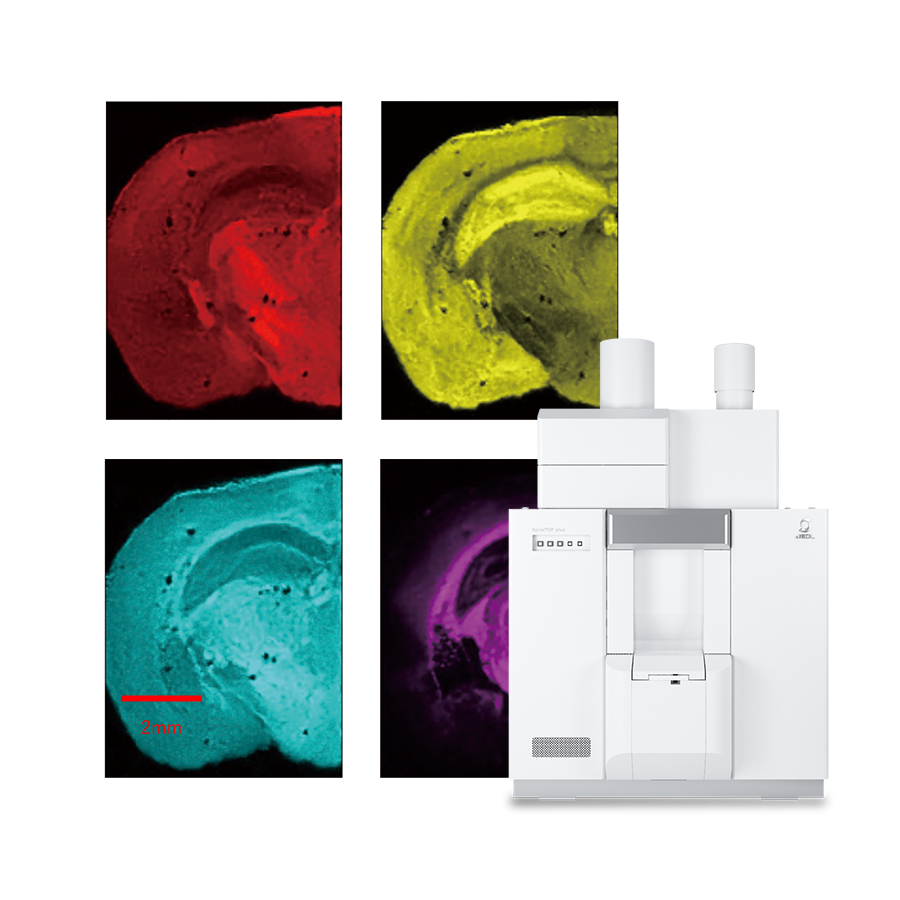
Features
◆Click the play button in the above box to watch the video. (3min 30sec.)◆
Applications shown in the movie:
Distribution of lipids (phospholipids and fatty acids) in thyroid cancer tissues
Mass spectrometry imaging on mixed conductive/non-conductive substrate using JMS-S3000 SpiralTOF™
Other mass spectrometry imaging applications are here.
Why high mass-resolving power is required for MS imaging?
MALDI MS imaging was initially developed to focus on high molecular weight compounds such as proteins and peptides. However, with the expanding applications of MALDI MS imaging, the interests have shifted to include smaller molecules such as lipids, pharmaceuticals, and pharmaceutical metabolites. Conventional MALDI - reflectron TOFMS has difficulty discerning small molecule signals from matrix molecules. In the case of MALDI MS imaging, signals from unwanted molecules on the specimen surface will often interfere with signals from the target analytes. High selectivity by means of high mass-resolving power is essential for obtaining reliable target analyte spatial distributions.
The SpiralTOFTM-plus 3.0 with its high mass-resolving power is indispensable for MALDI MS imaging.
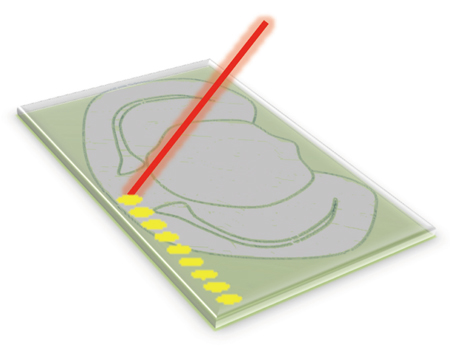
A tissue section is placed on an ITO-coated glass slide, and matrix solution is sprayed onto the surface.
The specimen is moved beneath the focused laser beam to create a time dependent series of mass spectra where each time corresponds to a specific spatial location. Analysis of the data allows the researcher to visualize the spatial distribution of specific compounds on the sample surface.
Mass spectrometry imaging data can be analyzed with the JEOL msMicroImagerTM software (optional) or converted to a common data format imzML which allows data analysis by SCiLS Lab MVS (optional) or other third-party software such as BioMap.
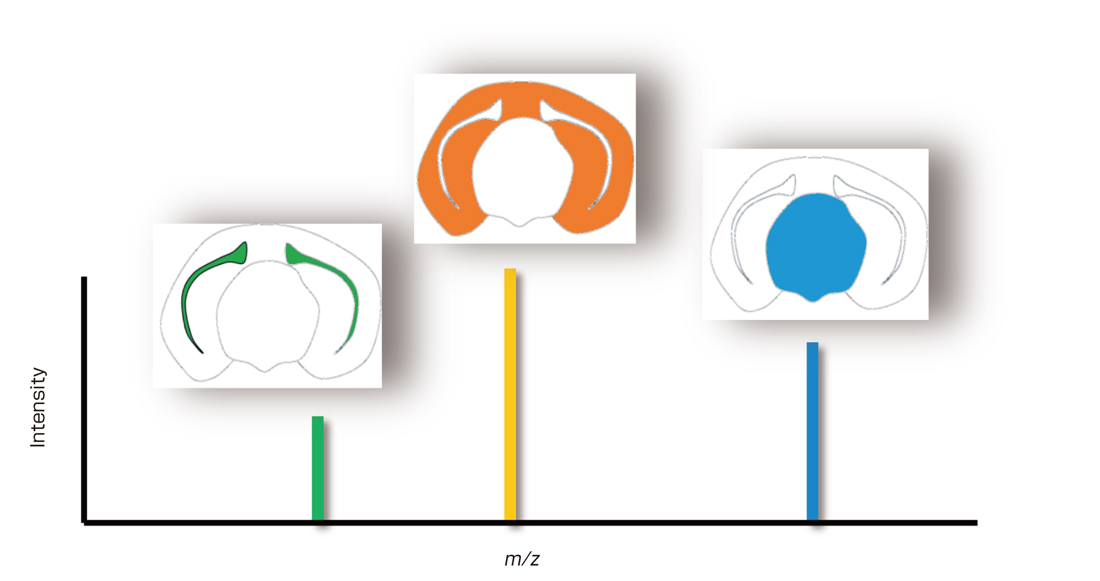
FINE-AI Filter: Noise Filtering Using AI (Machine Learning) Technology
Our newest MS imaging data processing software msMicroImagerTM version 3 (optional) is now equipped with FINE-AI Filter, a noise filtering technology that uses AI (machine learning). This new FINE-AI Filter originates from the JEOL LIVE-AI (Live Image Visual Enhancer-AI) technology developed for our scanning electron microscopes (SEM), which was re-optimized for MS imaging and implemented to achieve significant improvements to the quality of MS images.
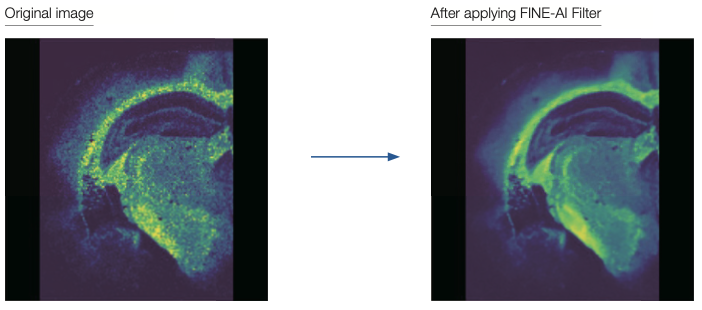
Mass Spectrometry Imaging Analysis of Lipids in Mouse Brain Tissue Section
Mouse brain sections contain a variety of lipid classes. A mass spectrum obtained from a tissue section is highly complex, especially in the region of m/z 700 - 1,000. Many of the peaks in the mass spectrum are less than 10% of the base peak, representing minor components. MALDI MS imaging of lipids requires a mass-resolving power high enough to separate the minor peaks from interferences. The bottom mass spectrum below shows the expansion of m/z 820 - 823. Many peaks were separated from each other by less than 0.1 u. The high mass-resolving power of the SpiralTOFTM-plus 3.0 clearly separated these isobaric peaks, thus allowing the elucidation of 4 lipid elemental compositions. Moreover, each lipid clearly showed a different spatial distribution. Elucidation of elemental compositions and accurate determination of spacial distributions for each lipid would be difficult with a conventional reflectron TOFMS with moderate mass-resolving power.
By applying the AI noise filter, FINE-AI Filter, MS images of even higher quality can be obtained.
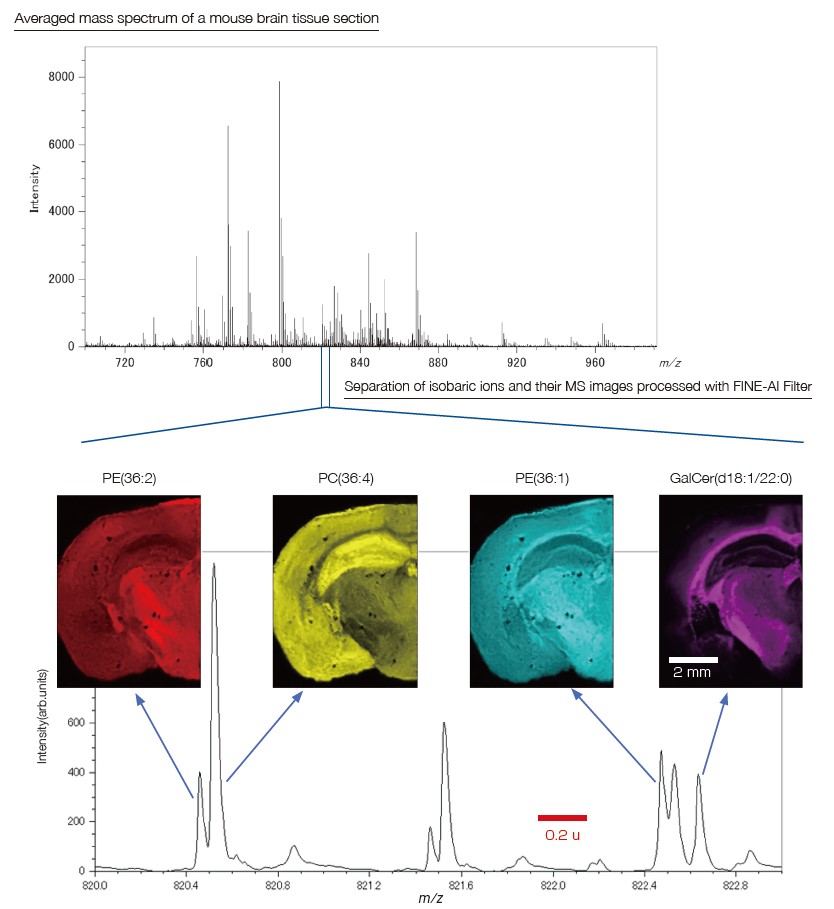
PE: Phosphatidyl ethanolamine, PC: Phosphatidyl Choline, GalCer: Galactosylceramide
Separation of isobaric ions and their MS images processed with FINE-AI Filter
This data was acquired in a joint research project with the Mass Spectrometry Group, Project Research Center for Fundamental Sciences, Graduate School of Science, Osaka University.
The tissue section specimen was provided by Awazu Laboratory, Division of Sustainable Energy and Environmental Engineering, Graduate School of Engineering, Osaka University.
Statistical Analysis of Mass Spectrometry Imaging Data by using SCiLS Lab MVS
Advanced statistical data analysis was performed based on all of the mass spectral peaks detected in the data above by using SCiLS Lab MVS. Segmentation of the characteristic regions and extraction of the mass spectrum from each segment facilitated by the high mass-resolving power of the JMS-S3000 SpiralTOF™-plus have been achieved.
Result of pLSA (probabilistic latent semantic analysis)
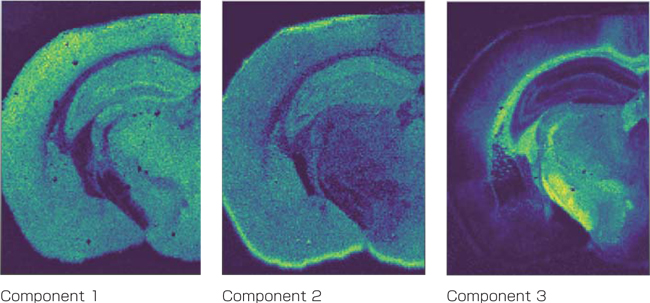
Relationship between pLSA score plot and Segmentation
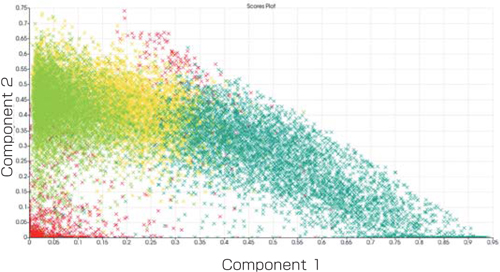
Segmentation
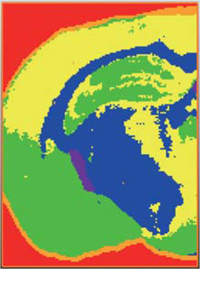
Mass spectra from respective segments
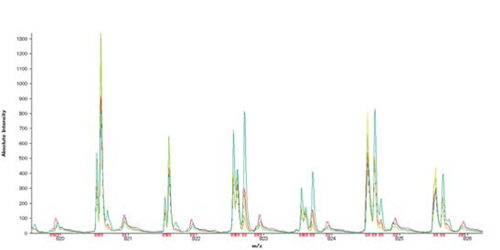
Analyzed with SCiLS Lab MVS, Version 2020b Premium3D
Mass spectrometry imaging data analysis of synthetic polymers by using msMicroImager™
In conventional MS imaging, a MS image is extracted by specifying a specific m/z range. However, since polymers are polydisperse and have molecular weight distributions, the conventional method can generate only a mass image of a specific degree of polymerization, and the spatial distribution of the polymer as a whole cannot be visualized. To solve this problem, msMicroImager™ can generate an image with the number average molecular weight (Mn), weight average molecular weight (Mw), and polydispersity (D) of the polymer. This makes it possible to visualize the spatial distribution of polymers more intuitively by consolidating hundreds of mass images derived from each degree of polymerization / isotope peak into three images.
MS Imaging of polyethylene glycols having different molecular weight distributions (MSTips No.305)
A conventional method can visualize the distribution of a polymer species with a specific degree of polymerization.
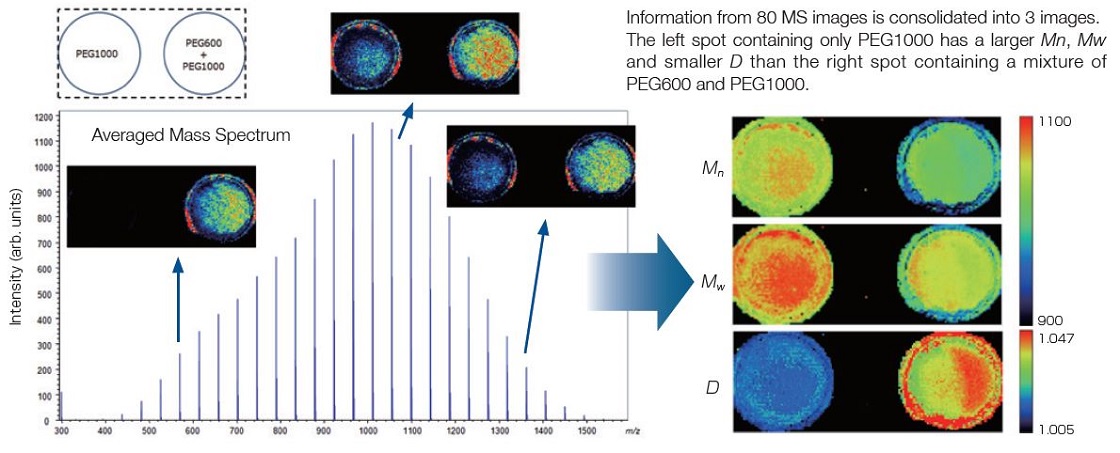
Mass Spectrometry Imaging Analysis of Polymers by Combining msMicroImager™ and msRepeatFinder
Specifications
Options
| Model name | Description | |
|---|---|---|
| Target plates | Adapter for glass sample plate | For ITO glass sample plates (Hudson Surface Technology; HST) |
| ITO glass sample plate | Slide glass, 0.7 mm thick, 25 pc/pkg | |
| Multi-target plate | For thick specimens
Indentations for 0.5 mm thick and 1.0 mm thick specimens. |
|
| Software | MS Imaging Support Program |
1D (line) scan and 2D scan (imaging) data acquisition. Convert MS imaging raw data into imzML format. |
|
msMicroImager™ MS Imaging Viewer Program |
Read MS imaging raw data acquired by msTornado™ Control. Perform pixel binning. Extract and export MS images. Export mass spectra of the regions of interest. Browse MS images. Change color map of the images. Perform arithmetic operations between MS images. Import images, including optical images from microscopes and scanners. Overlay MS and imported images. Noise reduction and image quality improvement with FINE-AI Filter. Generation of images based on average molecular weight and polydispersity. |
|
| SCiLS Lab MVS (Bruker Daltonik GmbH) | Comparative analysis, co-localization analysis, spatial segmentation, component analysis, classification model calculation, organizational quantification |
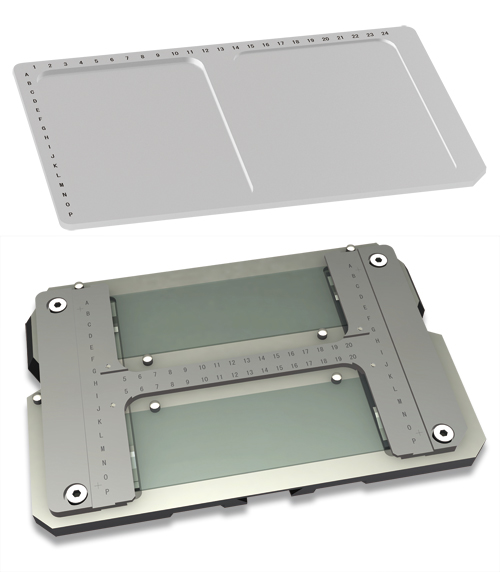
Top: multi-target plate for thick specimens (for 0.5 mm thick and 1.0 mm thick specimens)
Bottom: sample plate holder for ITO (indium tin oxide) coated glass slide by Hudson Surface Technology
Catalogue Download
JMS-S3000 SpiralTOF™-plus 3.0 Mass Spectrometry Imaging System
Application
Application MS-Imaging
JMS-S3000 SpiralTOF™ series Imaging Applications Notebook
JMS-S3000 SpiralTOF™ series Life Science Applications Notebook
JMS-S3000 SpiralTOF™ series Polymers, Materials, & Chemistry Applications Notebook
JMS-S3000 SpiralTOF™ series Shared Instrument Applications Notebook
Workflow for Molecular Structure Analysis of Transition Metal Complexes
Comprehensive Analysis of Acetylacetonate Complexes
Molecular Structure Analysis of Alkaloids
Molecular Structure Analysis of Organic Compounds used in Agricultural and Food Chemistry
MALDI Application: Structural analysis of EO-PO copolymers using high-resolution MALDI-TOFMS and NMR
JMS-S3000 SpiralTOF™ Imaging Applications Notebook
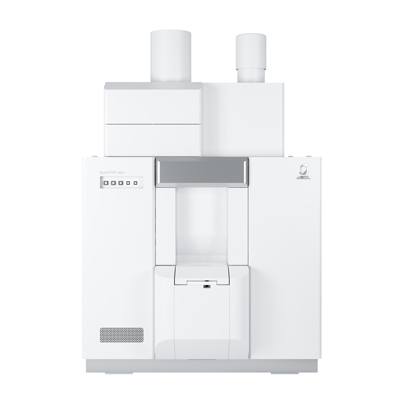
Applications Notebook for the MS imaging applications of JMS-S3000 SpiralTOF Matrix-Assisted Laser Desorption/Ionization - Time-of-Flight Mass Spectrometer (MALDI-TOFMS).
Related Products
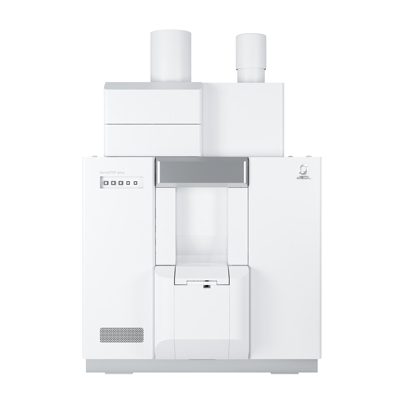
MALDI: JMS-S3000 SpiralTOF™-plus 3.0 Matrix-Assisted Laser Desorption/Ionization Time-of-Flight Mass Spectrometer
The JMS-S3000 SpiralTOF™-plus 3.0 is a MALDI-TOFMS* that uses innovative SpiralTOF ion optics that has been updated to extend the mass range of this high resolution system. The JMS-S3000 defines a new standard in MALDI-TOFMS performance and provides state-of-the-art analytical solutions for a wide range of research areas such as functional synthetic polymers, materials science, and biomolecules.
◆ Clicking the Play button starts the video (approx. 4 minutes).
Matrix-Assisted Laser Desorption/Ionization Time-of-Flight Mass Spectrometer
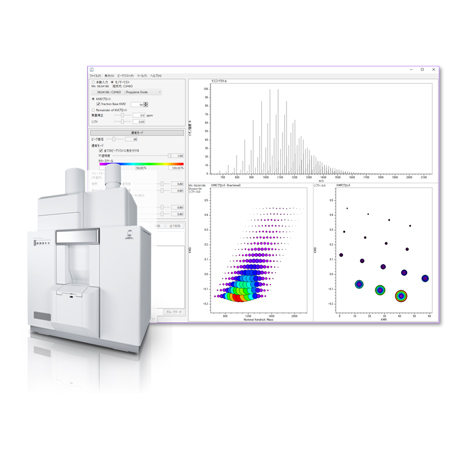
msRepeatFinder Polymer Analysis Software
Definitive Polymer Analysis Software !!
Visualizes complicated mass spectral data and accelerates information sharing !
More Info
Are you a medical professional or personnel engaged in medical care?
No
Please be reminded that these pages are not intended to provide the general public with information about the products.
